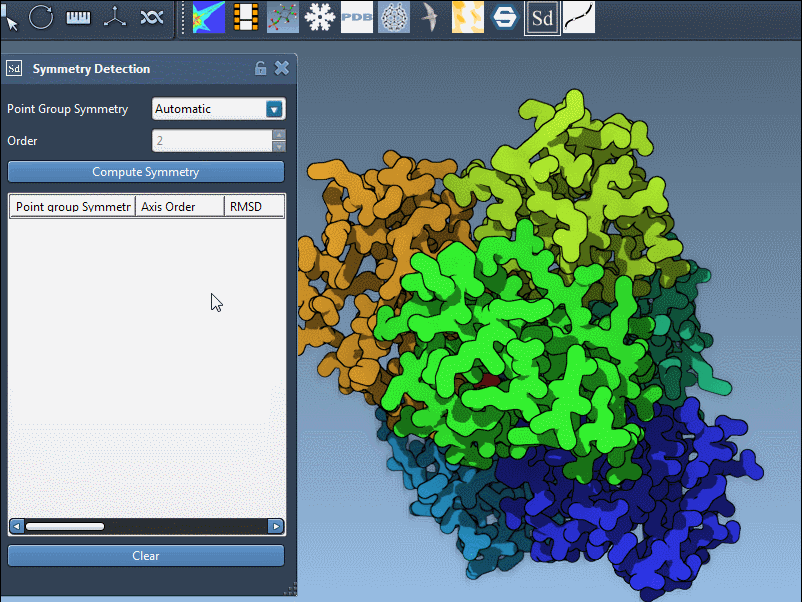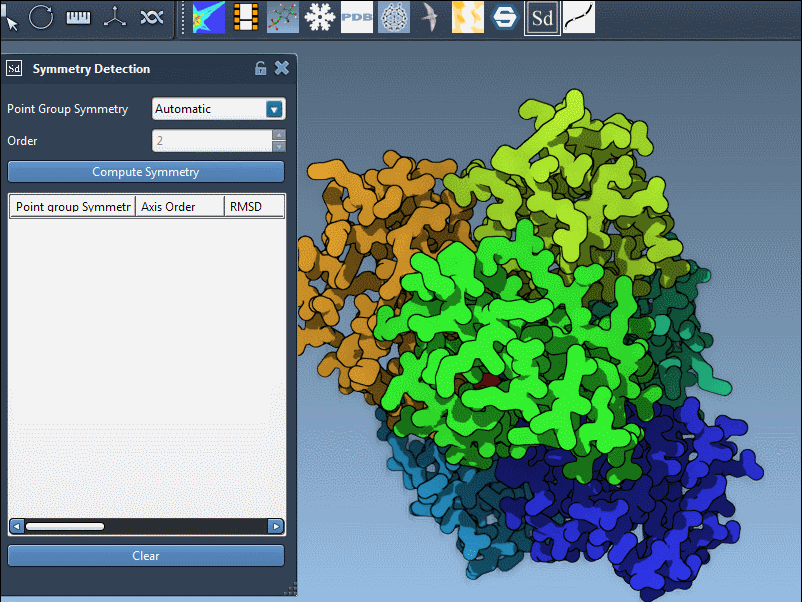Biological assemblies—like protein complexes or viral capsids—often exhibit beautiful symmetry, which can be more than just aesthetic. Understanding and using this symmetry is essential in many molecular modeling workflows: from reducing computational cost to designing symmetric mutations.
That said, if you’re working with a complex assembly and run a symmetry detection tool like SAMSON’s Symmetry Detection extension, you might end up with multiple possible symmetry groups. So the big question is: how do you know which one to choose?
Why multiple symmetries?
For complex structures, SAMSON’s automatic symmetry detection might suggest several plausible symmetry groups. Each group contains symmetry axes and an overall RMSD score that quantifies how well the predicted symmetry fits the molecular structure.
Two key criteria for choosing the best group
- Higher symmetry order is generally preferred. For example, if both C3 (cyclic order 3) and D3 (dihedral order 3) are offered, D3 is more informative because it includes a horizontal 2-fold axis in addition to the primary rotation axis.
- Smaller RMSD values indicate a better symmetry fit. The lower the RMSD, the closer the structure aligns with itself under the detected symmetry transformations.
By focusing on these two criteria, you can make a better-informed decision that improves downstream modeling steps, especially if your workflow includes simulations on asymmetric units or the design of symmetric nanostructures.
An example: 1B4B
Let’s take the 1B4B system. SAMSON detects a dihedral symmetry of order 3 (D3). Here’s how you could analyze that:
- Click on the symmetry group
D3in the detected list to highlight its primary axis in the viewport. - Expand the group to view its individual symmetry axes and their RMSD.
- Single-click an axis to visualize it; double-click to align your camera view along it. This makes inspection easier and can help validate whether it matches your biological expectations.

Manual override: what if you know the expected symmetry?
Occasionally, experimental data or the biological function of the complex suggests a specific symmetry. In such cases, you can skip automatic detection and specify the group manually from SAMSON’s dropdown lists.

Visual aids can help
Structure inspection becomes easier with good visualization strategies:
- Combine symmetry axes with ribbons or surfaces.
- Use different colors for asymmetric units to highlight patterns.
- Capture viewport snapshots for publication or sharing.
Conclusion
Even when a tool helps automate symmetry detection, choosing the right group is ultimately about understanding the molecular context. Aim for high-order groups with low RMSD, and don’t hesitate to set expectations manually when you have prior knowledge.
To learn more about symmetry detection and visualization in SAMSON, visit the official documentation page.
SAMSON and all SAMSON Extensions are free for non-commercial use. You can get SAMSON at https://www.samson-connect.net.





